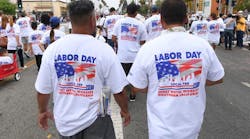In the 1830’s manufacturing employees put in 70 hours per week.
By 1882 they had enough of that and wanted to unify union workers to get a reduction in working hours.
The first Labor Day was held in 1882 in New York City and was sponsored by the Central Labor Union. “The organizers of the first Labor Day were interested in creating an event that brought different types of workers together to meet each other and recognize their common interest,” writes Jay L. Zagorsky, on simithsonian.com. The goal was to move to an eight hour working day, six days a week.
To create the holiday, the unions had to declare a one-day strike in the city.
It worked and by 1890, manufacturing workers were putting in 60 hours a week, however, that was a far cry from the 40-hour work-week of today.
Another interesting angle on this story, Zagorsky points out, is that employers were in favor of the shortened working hours. It allowed workers to spend their earnings boosting the transformation of the U.S. economy. By the late 1800s and early 1900s, the economy was moving away from farming towards manufacturing and thus began to rely on consumer’s purchasing power of the increasing number of goods that were being produced.
To gain further insights into the holiday read Zagorsky’s article here.




